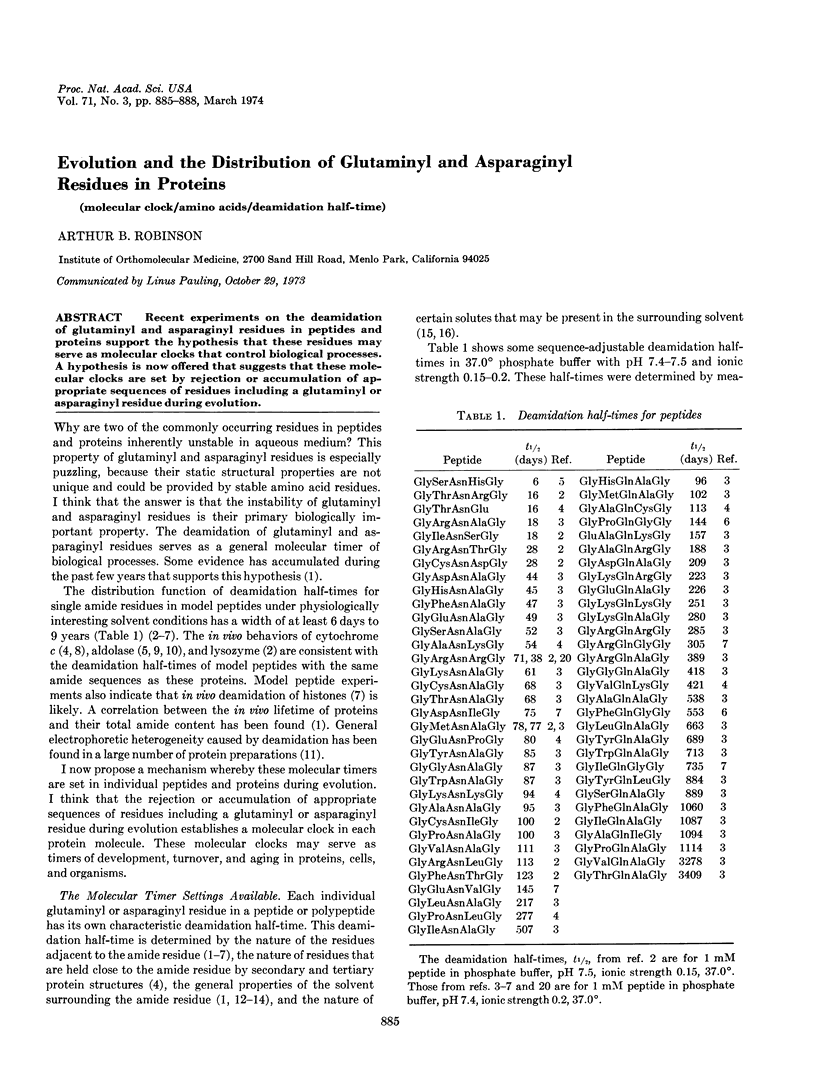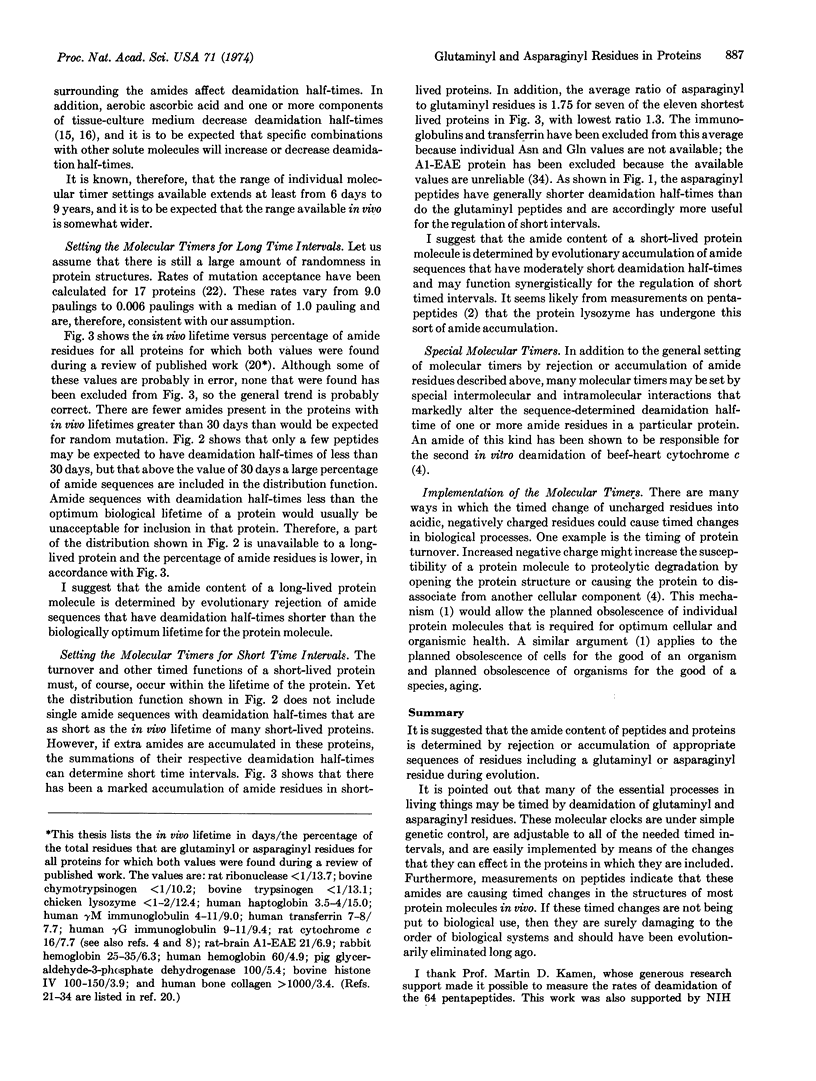Abstract
Recent experiments on the deamidation of glutaminyl and asparaginyl residues in peptides and proteins support the hypothesis that these residues may serve as molecular clocks that control biological processes. A hypothesis is now offered that suggests that these molecular clocks are set by rejection or accumulation of appropriate sequences of residues including a glutaminyl or asparaginyl residue during evolution.
Keywords: molecular clock, amino acids, deamidation half-time
Full text
PDF



Selected References
These references are in PubMed. This may not be the complete list of references from this article.
- DAVISON A. N. Metabolically inert proteins of the central and peripheral nervous system, muscle and tendon. Biochem J. 1961 Feb;78:272–282. doi: 10.1042/bj0780272. [DOI] [PMC free article] [PubMed] [Google Scholar]
- EASTOE J. E. The amino acid composition of mammalian collagen and gelatin. Biochem J. 1955 Dec;61(4):589–600. doi: 10.1042/bj0610589. [DOI] [PMC free article] [PubMed] [Google Scholar]
- FLETCHER M. J., SANADI D. R. Turnover of rat-liver mitochondria. Biochim Biophys Acta. 1961 Aug 5;51:356–360. doi: 10.1016/0006-3002(61)90177-9. [DOI] [PubMed] [Google Scholar]
- Flatmark T. On the heterogeneity of beef heart cytochrome c. 3. A kinetic study of the non-enzymic deamidation of the main subfractions (Cy I-Cy 3). Acta Chem Scand. 1966;20(6):1487–1496. doi: 10.3891/acta.chem.scand.20-1487. [DOI] [PubMed] [Google Scholar]
- Flatmark T., Sletten K. Multiple forms of cytochrome c in the rat. Precursor-product relationship between the main component Cy I and the minor components Cy II and Cy 3 in vivo. J Biol Chem. 1968 Apr 10;243(7):1623–1629. [PubMed] [Google Scholar]
- Hansen N. E., Karle H., Andersen V. Lysozyme turnover in the rat. J Clin Invest. 1971 Jul;50(7):1473–1477. doi: 10.1172/JCI106632. [DOI] [PMC free article] [PubMed] [Google Scholar]
- KELLER P. J., COHEN E., NEURATH H. The proteins of bovine pancreatic juice. II. Rates of synthesis in vivo of the cationic proteins. J Biol Chem. 1959 Feb;234(2):311–315. [PubMed] [Google Scholar]
- Lai C. Y., Chen C., Horecker B. L. Primary structure of two COOH-terminal hexapeptides from rabbit muscle aldolase: a difference in the structure of the alpha and beta subunits. Biochem Biophys Res Commun. 1970 Jul 27;40(2):461–468. doi: 10.1016/0006-291x(70)91031-4. [DOI] [PubMed] [Google Scholar]
- MORRIS A. J., DICKMAN S. R. Biosynthesis of ribonuclease in mouse pancreas. J Biol Chem. 1960 May;235:1404–1408. [PubMed] [Google Scholar]
- McKerrow J. H., Robinson A. B. Deamidation of asparaginyl residues as a hazard in experimental protein and peptide procedures. Anal Biochem. 1971 Aug;42(2):565–568. doi: 10.1016/0003-2697(71)90074-1. [DOI] [PubMed] [Google Scholar]
- Midelfort C. F., Mehler A. H. Deamidation in vivo of an asparagine residue of rabbit muscle aldolase. Proc Natl Acad Sci U S A. 1972 Jul;69(7):1816–1819. doi: 10.1073/pnas.69.7.1816. [DOI] [PMC free article] [PubMed] [Google Scholar]
- NEUBERGER A., NIVEN J. S. F. Haemoglobin formation in rabbits. J Physiol. 1951 Feb;112(3-4):292–310. doi: 10.1113/jphysiol.1951.sp004530. [DOI] [PMC free article] [PubMed] [Google Scholar]
- Piha R. S., Cuénod M., Waelsch H. Metabolism of histones of brain and liver. J Biol Chem. 1966 May 25;241(10):2397–2404. [PubMed] [Google Scholar]
- Robinson A. B., Irving K., McCrea M. Acceleration of the rate of deamidation of GlyArgAsnArgGly and of human transferrin by addition of L-ascorbic acid. Proc Natl Acad Sci U S A. 1973 Jul;70(7):2122–2123. doi: 10.1073/pnas.70.7.2122. [DOI] [PMC free article] [PubMed] [Google Scholar]
- Robinson A. B., McKerrow J. H., Cary P. Controlled deamidation of peptides and proteins: an experimental hazard and a possible biological timer. Proc Natl Acad Sci U S A. 1970 Jul;66(3):753–757. doi: 10.1073/pnas.66.3.753. [DOI] [PMC free article] [PubMed] [Google Scholar]
- Robinson A. B., Scotchler J. W., McKerrow J. H. Rates of nonenzymatic deamidation of glutaminyl and asparaginyl residues in pentapeptides. J Am Chem Soc. 1973 Nov 28;95(24):8156–8159. doi: 10.1021/ja00805a032. [DOI] [PubMed] [Google Scholar]
- Robinson A. B., Tedro S. Sequence dependent deamidation rates for model peptides of hen egg-white lysozyme. Int J Pept Protein Res. 1973;5(4):275–278. doi: 10.1111/j.1399-3011.1973.tb03461.x. [DOI] [PubMed] [Google Scholar]
- VELICK S. F. The metabolism of myosin, the meromyosins, actin and tropomyosin in the rabbit. Biochim Biophys Acta. 1956 Apr;20(1):228–236. doi: 10.1016/0006-3002(56)90281-5. [DOI] [PubMed] [Google Scholar]
- Wood J. G., King N. Turnover of basic protein of rat brain. Nature. 1971 Jan 1;229(5279):56–58. doi: 10.1038/229056a0. [DOI] [PubMed] [Google Scholar]


